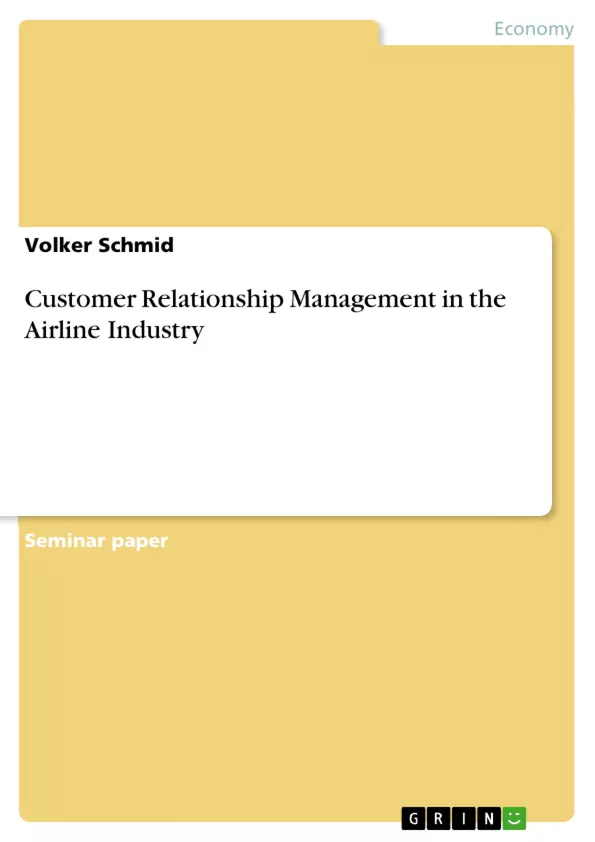To analyse the consumer behaviour presents an important criteria to be successful in the airline industry. This text gives answers to most relevant questions regarding consumer behaviour, using Air Lingus as an example. Finally, it includes a plan to implement a relationship marketing programme.
Table of Contents
- Examine how the concept of relationship marketing might improve the levels of satisfaction with Aer Lingus by its customers and other publics.
Objectives and Key Themes
This case study aims to explore how relationship marketing can enhance customer and public satisfaction with Aer Lingus. It investigates the core concepts of relationship marketing, customer satisfaction, and the various publics involved in the airline's operations.
- Relationship Marketing: Definition, theoretical approaches, and elements.
- Customer Satisfaction: Determinants and connection to relationship marketing.
- Aer Lingus' Publics: Identifying and categorizing key stakeholders.
- The impact of relationship marketing on overall satisfaction.
- Models of relationship marketing and their application to Aer Lingus.
Chapter Summaries
Examine how the concept of relationship marketing might improve the levels of satisfaction with Aer Lingus by its customers and other publics: This chapter delves into the core concept of relationship marketing, exploring its various definitions and theoretical underpinnings from different perspectives. It contrasts relationship marketing with transactional marketing, highlighting key distinctions such as long-term orientation, customer commitment, and focus on benefits versus features. The chapter also examines various models of relationship marketing, including the Morgan and Hunt model (1994) which categorizes relational exchanges and Ford's (1980) model distinguishing between overall and individual relationships. Furthermore, it defines 'customers' and 'other publics' using Applebaum's (1980) distinction between customers and consumers, and Payne's (in Cranfield School of Management, 2004) 'six-market model,' which encompasses internal markets, referral markets, influence markets, recruitment markets, supplier markets, and customer markets. The chapter lays the groundwork for understanding how relationship marketing strategies can be implemented to improve satisfaction across all these stakeholder groups. The concept of customer satisfaction and its connection to expectation, performance, and disconfirmation are also introduced, setting the stage for the application of these concepts within the Aer Lingus context.
Keywords
Relationship marketing, customer satisfaction, Aer Lingus, stakeholder management, customer relationship management (CRM), transactional marketing, publics, six-market model, customer retention.
Aer Lingus Case Study: Relationship Marketing and Customer Satisfaction - FAQ
What is the overall aim of this case study?
This case study explores how relationship marketing can enhance customer and public satisfaction with Aer Lingus. It investigates core concepts of relationship marketing, customer satisfaction, and the various publics involved in the airline's operations.
What are the key themes explored in the study?
The key themes include: defining relationship marketing and its theoretical approaches; understanding customer satisfaction and its determinants; identifying and categorizing Aer Lingus' key stakeholders (publics); analyzing the impact of relationship marketing on overall satisfaction; and applying models of relationship marketing to the Aer Lingus case.
What models of relationship marketing are discussed?
The study discusses the Morgan and Hunt model (1994) which categorizes relational exchanges, and Ford's (1980) model differentiating between overall and individual relationships.
How does the study define 'customers' and 'other publics'?
The study uses Applebaum's (1980) distinction between customers and consumers, and Payne's (Cranfield School of Management, 2004) 'six-market model,' encompassing internal, referral, influence, recruitment, supplier, and customer markets to define these terms.
What is the significance of the six-market model in this context?
The six-market model helps to identify and categorize the various stakeholder groups (publics) with whom Aer Lingus interacts, allowing for a comprehensive understanding of how relationship marketing strategies can impact satisfaction across all these groups.
How is customer satisfaction defined and related to relationship marketing?
Customer satisfaction is defined in relation to the gap between customer expectations and perceived performance. The study explores how relationship marketing strategies aim to bridge this gap and foster long-term customer commitment.
What are the key differences between relationship marketing and transactional marketing?
The study highlights key distinctions such as long-term orientation versus short-term transactions, customer commitment versus individual sales, and a focus on benefits versus features.
What are the key takeaways from the chapter summarizing the concept of relationship marketing and its potential to improve Aer Lingus' customer and public satisfaction?
This chapter provides a foundational understanding of relationship marketing, contrasting it with transactional marketing, and introducing key models and definitions. It lays the groundwork for understanding how relationship marketing can improve satisfaction across all stakeholder groups by focusing on long-term relationships and customer commitment.
What are the key words associated with this case study?
Relationship marketing, customer satisfaction, Aer Lingus, stakeholder management, customer relationship management (CRM), transactional marketing, publics, six-market model, customer retention.
- Quote paper
- Volker Schmid (Author), 2005, Customer Relationship Management in the Airline Industry, Munich, GRIN Verlag, https://www.grin.com/document/38130



